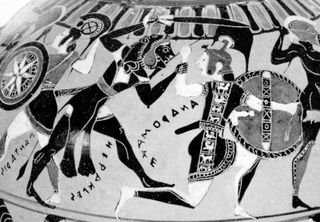
(Source)
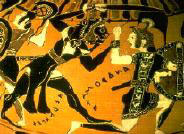
“In the picture, above Herakles (dressed in his customary lion-skin) attacks an Amazon (right), bringing her to her knees. Above: Detail from an Athenian black-figure clay vase, about 550 BC. Boston, Museum of Fine Arts 98.916. © Boston, Museum of Fine Arts, Licence Plate 11 UK 1007 108”
Source
The myth behind this piece: Herakles (a famous warrior depicted extensively in Greek art) had killed his own wife and children, and as punishment was required to perform twelve labors. The ninth labor required him to retrieve the belt of Andromache (alternatively called Hippolyte), queen of the Amazons. In keeping with ancient conventions, Andromache is depicted with white skin. Notice, however, that she wears men’s battle dress. Additionally, as in other depictions of Greek warriors fighting Amazons, Herakles is on the verge of triumph, while Andromache is on the verge of defeat.

Above middle: 'The Ephesus Amazons'. Drawing from John Boardman, Classical Sculpture Fig. 195. © John Boardman
(Source)
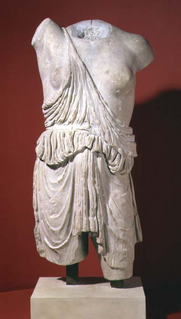
Marble statuette of an Amazon; Roman, preserved height 104 cm. A Roman version of a Greek original of the 5th century BC.
From the website:“The elder Pliny, the Roman encyclopaedist, tells the story of a competition in ancient Greece for a statue of the Amazon for the temple of Artemis at Ephesus. The artists involved (who included Phidias, Polyclitus, and Cresilas) had to choose the winner, and this proved to be the Amazon ‘which each artist had placed second to his own’, namely the one made by Polyclitus. The Ashmolean’s Amazon may well relate to such a project.”
Source: the Ashmolean
Many people have the misconception that Amazons cut off one breast, since the Greek word “amazon” (a--without; mazos--breast) means “breastless.” However, this was a Greek mistranslation of an Iranian word which means “warriors.”
Also, notice that Greek art did not always depict Amazons with only one breast. The statue above, for example, has two breasts.
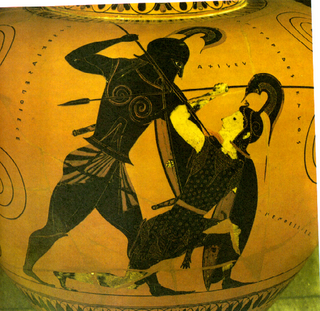
(large detail of the vase below, from www.holycross.edu)

Black-figured amphora (wine-jar) signed by Exekias as potter and attributed to him as painter
Greek, about 540-530 BC
Made in Athens, Greece; found at Vulci (now in Lazio, Italy)
Achilles killing the Amazon Queen Penthesilea
“Penthesilea brought her Amazon warriors to help the Trojans defend their city, but was killed in combat with Achilles, the greatest of the Greek warriors. The scene on this vase shows Achilles looming above her as she sinks to the ground. Achilles's face is masked and protected by his helmet; Penthesilea's helmet is pushed back to expose her features and emphasize her vulnerability at this vital moment. Her spear passes harmlessly across Achilles's chest, while his pierces her throat and blood spurts out. According to a later version of the story, at this very moment the eyes of the two warriors met and they fell, too late, in love.“ (Source: the British Museum)
As with the earlier vase of Herakles fighting Andromache, the Greek hero is in a position of strength, whereas the Amazon is about to be defeated. Notice that Penthesilea’s skin is painted white and that she is wearing men’s battle dress.This amphora is an example of black-figure pottery (meaning that the background is red and the people--figures--are black). The red and black are colors that come from the process of firing the pot; however, the white would have been painted on after firing. Exekias is one of the most famous black-figure potters (another famous example of his work is Ajax and Achilles playing dice).
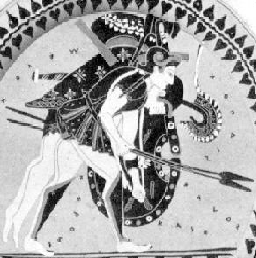
(Source)
An Amazon carrying an injured one from the battlefield.
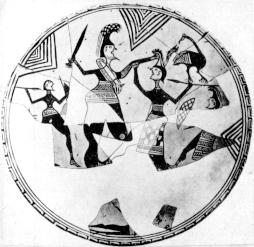
(Source)
From the Web site: “This picture shows the earliest, largely accepted representation of Amazons. It dates back to 700 BC. The two figures on the right side are interpreted as Amazons, at least they are female warriors, because little circles on the chest indicate their breasts. They are armed with spear and shield and they wear a long patterned gown and a very broad girdle.Most probably it depicts the fight between Heracles and the Amazon Queen Hippolyte.”
Although the figures are dressed similarly in this piece, the figure holding the sword is probably Herakles and the figure whose hair is being pulled is probably Hippolyte (Andromache).
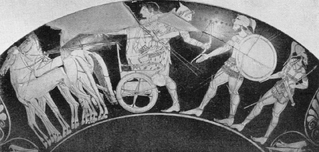
(Source)
The Abduction of Antiope
68,4 no.7 p.124 Attic Black-figured Cup. London E41.
"Antiope is dressed and equipped as an archer with trousers, a sleeved jacket, and a pointed cap. A quiver hangs by her left side; in her left hand she holds the bow. There is a wreath on her cap and we also note the ear-ring. She leans forward and appears to scan the horizon for help."
Dietrich von Bothmer. 1957. Amazons in Greek Art. Oxford: Clarendon Press.
Notice the careful execution of the details in this decoration.
See the Wikipedia article about Antiope for a brief summary of the various versions of the myth.
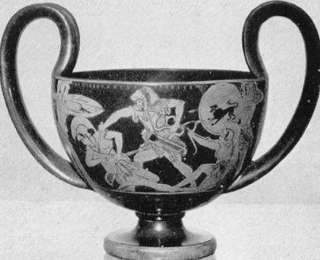
(Source)
Attic Red-Figure: Archaic and Later. Herakles and Amazons.
70,4a no10 p.132 Kantharos, Brussels A 718.
"Herakles is in the centre, stabbing an Amazon in the chest. To the right of Herakles an [Amazon] archer kneels beside a hoplite." [she is drawing her bow, aiming at Herakles]
Dietrich von Bothmer. 1957. Amazons in Greek Art. Oxford: Clarendon Press.
This is a later painting of Herakles and Andromache. However, the main element is the same; Herakles dominates Andromache.
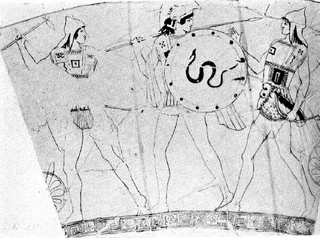
(Source)
Attic Red-Figure: Archaic and Later. Herakles and Amazons.
70,5b no.18 p.132 Stamnos. Leningrad 807.
"Three Amazons are shown setting out. The first is an archer and carries a bow and a battle-axe; the second is equipped like a hoplite; the third is another archer. The archers wear chitons, corslets, and oriental pointed caps." [This figure is very unusual in style. The rendering of the legs is very lifelike. Note how short the bow is in the hand of the right-hand archer]
Dietrich von Bothmer. 1957. Amazons in Greek Art. Oxford: Clarendon Press.
These Amazons are shown wearing a mix of Greek and Persian clothing.
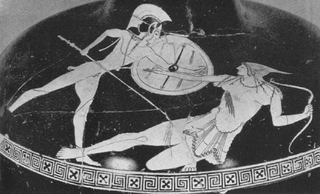
(Source)
Attic Red-Figure: Archaic and Later. Amazonomachies, without Herakles.
71,1 no22 p.143 Hydriai, the picture on the shoulder. New York 10.210.19.
"Here a nude Greek has just inflicted a second wound on the thigh of an Amazon who is falling backward half-supported by her bow. The Amazon wears a belted chiton and a pointed cap. We note a disk-shaped ear-ring in her left ear. Her eye shows that she is dying, much blood gushes forth from her wounds below the right breast and on the right thigh. With her right arm she seems to plead for mercy; the palm of her hand is turned up, and her mouth is open. She must have been kneeling on her left knee before she was wounded; now she has lost her balance and her right leg is stretched out. The artist has drawn her much taller than the Greek, but the discrepancy in scale is probably occasioned by the difficult foreshortening and novel pose."
Dietrich von Bothmer. 1957. Amazons in Greek Art. Oxford: Clarendon Press.
Defeating an Amazon was considered an act of strength and manliness, since Amazons were considered to be fantastic warriors. As is evidenced in this depiction, not only great heroes (e.g., Herakles and Achilles) could defeat Amazons; regular Greek soldiers could defeat them, too.
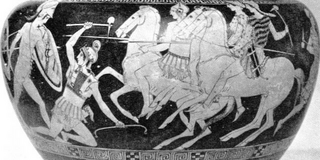
(Source)
Attic Red-Figure: Early Classic and Classic. The Big Battles.
77.2 no.12 p.162 Dinoi. London 99.7-21.5.
"Theseus, followed by Perithous and a companion, rushes up to Andromache who has fallen on her left knee and raises her right arm with the axe in a last effort at resistance. Blood pours from the wound in her right thigh. Behind her, Hippolyte and two other Amazons ride up to defend the fallen queen."
Dietrich von Bothmer. 1957. Amazons in Greek Art. Oxford: Clarendon Press.
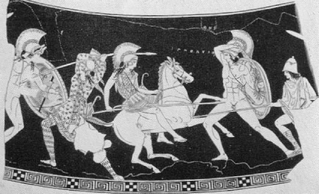
(Source)
Attic Red-Figure: Early Classic and Classic: With Mounted Amazons
77,6 no.30 p.177 Squat lekythos. Boston 95.48.
"The group on the right is the familiar one of a mounted Amazon fighting two Greeks; here the Amazon wears not the oriental costume but chiton, cuirass and helmet. On the left a Greek is attacked by an Amazon."
Dietrich von Bothmer. 1957. Amazons in Greek Art. Oxford: Clarendon Press.
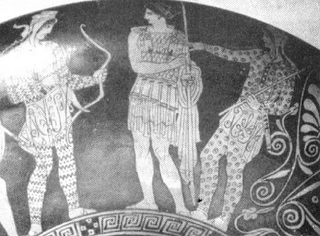
(Source)
Attic Red-Figure: Early Classic and Classic: Amazons by themselves.
86,4 no. 189 p. 206 Lekythoi. Canea 6, from Polyrrhenia.
"The Amazons by the Canea painter are all archers." "Amazon in oriental costume with bow."
Dietrich von Bothmer. 1957. Amazons in Greek Art. Oxford: Clarendon Press.
In many of the depictions we have shown above, the Amazons were dressed in Greek men’s battle gear. There are other pieces, though, that show them wearing Persian dress; the painting above is a excellent example of this.The Greeks had a taboo against depicting any Greek women in their art; depicting Amazons was a way to get around this taboo, especially if the Amazons were wearing men’s battle gear or clearly foreign clothing.
No comments:
Post a Comment